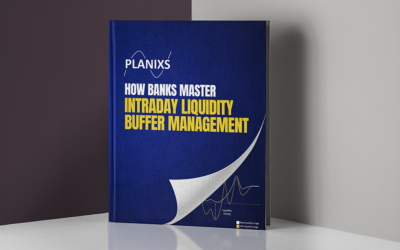Principles are good. They set the tone. The interpretation of these principles in regulation is necessary. However, and for example, regulations, such as a strong LCR didn’t help Credit Suisse. It has been mooted in certain quarters that the answer is ‘more’. More scrutiny, larger buffers, increased minimal LCR to above par. The art of ‘more’ usually means much greater cost which doesn’t always mean greater effectiveness. More power means bigger and heavier, usually; heavier usually means less agile. ’More’ can be an irrational response where there appears to be no alternative approach.
Nick Nicholls has over 35 successful years in investment banking and capital markets, working in prominent roles across front, middle and back office functions. In this article, he emphasises the transformative power of real-time data in liquidity risk management, arguing for a shift from more regulations to better data delivery, exploring how real-time solutions can enhance the application of the 2008 Sound Principles.
More regulation or better data?
I would argue ‘better’ as the alternative. Better data delivery (of anything) at the point it’s required and an instantaneous ability to translate that to decision-making and action. This does not require ‘more’ regulation. Today, unlike 15 years ago, firms have an opportunity to explore ‘better’ – this is real-time liquidity risk management. Real-time solutions augment the Principles for Sound Liquidity Risk Management and Supervision.
Principles for sound liquidity risk management and supervision
Principles for Sound Liquidity Risk Management and Supervision was written in 2008 as the Global Financial Crisis was about to drive contemporary economies into their most turbulent period.
The principles established the groundwork, giving rise to numerous liquidity regulations. These regulations, along with other principles and regulatory standards, originated from the banking supervision reforms of the Basel Committee, specifically Basel 3. The foundational pillars for capital and liquidity were established with a consensus that each supervisory body would incorporate these principles into its local regulations. This was agreed, as was a commitment to not allow any bank to become ‘too big to fail’.
Are we better off, 15 years on?
Some 15 years on from the 1st publication of ‘Sound Principles’ and Basel 3 we have an amalgamated Swiss bank that commentators are suggesting is larger than the rest of that economy put together.
Some political regimes have loosened certain aspects of Basel 3 regulations to spur more unrestricted growth, resulting in several bank failures.
Other factors include the impact and influence of technology on banks and markets; depositors are influenced through social media and can mobilise their funds electronically, and immediately. The concept of ‘sticky deposits’ no longer holds true, and the absence of stickiness may not always be influenced by rational sentiment.
In an environment where urgent calls are being made to extend current liquidity regulation and insist on greater levels of reserves, it’s probably a good time to revisit some aspects of those sound principles. This can be done through the lens of what a firm could be doing above and beyond regulation, considering how technology can support and enhance liquidity management.
This approach should provide greater control through more accurate and timely data delivery. It’s essentially about real-time liquidity management, which is considered ‘better.’
The ’6Rs’
This article focuses on aspects of the 2008 Sound Principles, exploring how they can be applied to a higher standard using real-time payment and securities data. Let’s just begin with some definitions:
Real-time liquidity, in essence, refers to the capability to promptly offer updated reports as data changes or when needed, in the desired format. This is accomplished by drawing on internal and external data sources that integrate operational efficiencies, regulatory compliance, liquidity optimisation, risk management, and business innovation. There are 5 key areas where elements of Sound Principles of Liquidity Risk Management (and supervision) can be augmented in real time. They are:
- Risk: An ability to provide and update exposure information that relates to securities and cash payments, transactions, and positions in real time
- Regulation: Real-time data allows you to immediately provide provisional updates to any regulation that has a liquidity component or lens.
- Resolution and recovery: Extent to which a firm can manage its own name or market stress and likely immediate outcomes related to those events.
- Revenue: Analysis enabling adjustment to funding and liquidity requirements in real time, which leads to right-sizing liquidity provisions –– as one example.
- Reputation: Enhancing decision-making contributes to a positive reputation. Moreover, grasping market and social sentiments and recognising their potential impact on your liquidity position can boost confidence in your organisation. The capacity to analyse and adjust expected outcomes in alignment with confidence or trust in an organisation amid evolving events is a crucial aspect of any liquidity framework.
It can be argued that real-time data provision assists or augments a firm’s ability to meet Risk Data Aggregation and Reporting regulation (BCBS239). Although directed at Globally significant international banks, these are sound principles for any institution.
Applying the “6R’s” to the Sound Principles
Principle 1: Fundamental principle for the management and supervision of liquidity risk.
This provides the groundwork for what is expected. Specifically, it says:
“A bank is responsible for the sound management of liquidity risk. A bank should establish a robust liquidity risk management framework that ensures it maintains sufficient liquidity, including a cushion of unencumbered, high-quality liquid assets, to withstand a range of stress events, including those involving the loss or impairment of both unsecured and secured funding sources.”
So we have LCR, NSFR, Intraday management and monitoring, ILAAP, and so on. These are reasonable – except all are based on past events and positions. Risk needs to be measured and managed against the here and now. A retrospective is no bad thing, but ‘sound principles’ was driven by the available technology at the time. We now can do better. Consider for instance a real-time Liquidity Coverage assessment.
Applying HQLA/ net cash flows in our new world where depositors of any category have the opportunity to move funds instantly. Run-off factors in real time aren’t necessary. A real time assessment of liquidity coverage would assume all deposits could move instantly.
Robustness can be measurably improved by understanding your exposure to liquidity shortfalls in real time and the impact those real-time updates can have on your ability to fund over the next few days. Where changes in depositor behaviour can be anticipated, analysis of these stresses can motivate mitigating strategies to reduce the impact.
High-quality liquid asset portfolios are subject to price movements. Understanding the impact of price volatility and how this impacts your liquidity coverage should be essential and therefore immediately available.
Instant access to ring-fenced assets that support liquidity buffers is essential, but so is understanding the entire unencumbered portfolio. Where it is, whether it’s accessible, and how quickly you can move it to cover the liquidity shortfall.
Adding a real-time capability enhances reputation, augments regulation, speeds recovery, informs liquidity risk, and adds to a firm’s sound liquidity practices. It should improve a firm’s ability to weather market disruption and provide added protection to its depositors.
Principles 2 and 3
Speak to the expectation that a firm should clearly articulate a liquidity risk tolerance appropriate for its business strategy and its role within financial systems, and apply those tolerances within policies, practices, and strategies to maintain adequate liquidity at all times. It also says that the bank’s board of directors should review and approve this strategy. The application of tolerance, strategies and policies need to be applied across currencies, jurisdictions, and legal entities.
Without the inclusion of real-time liquidity management and intraday reporting within this framework, a bank’s board strategy could be deficient. At best, this firm is likely to extend its tolerances which will incur unnecessary costs. At worst, those tolerances could be breached without knowing until well after the event.
The impact of an event localised in one market or one jurisdiction may see contagion to other areas of the group. Instantly understanding the implications of stress locally and in the group would enhance the ability to adjust against any stress outcomes.
There is a strong argument for a continuous assessment of applied tolerances against current cash flows and their related exposures. As an example, counterparty credit exposure and any collateral due on default along with any further potential contagion may see the need for those tolerances and contingencies to be adjusted. Being able to quantify outstanding net exposure in real time may allow for better responses and outcomes. Being able to adjust to the right position and reset tolerances would support any recovery and show enhanced control.
Technology now allows a controlled environment to set levels of acceptable overdraft or positive balances, as well as managing payments to within levels of available reserves, or managing payment flows against potential or excessive credit exposures, which can be adjusted in real time. Aptitude towards managing resilience and/ or recovery through critical periods can depend on the ability to adjust those tolerances and management of cash flows as required.
Principle 4
Speaks to funds transfer pricing and the equitable distribution of funding costs (and/ or revenues) across an organisation. By its nature, cost of funds allocation is an after-the-fact function of a Treasury division. However, a real-time understanding of available liquidity, the immediate requirement or use of reserves supporting a direct member’s LVPS activity can lead to better effective use of those reserves as required.
Fails management can also be improved with real-time settlement information. Better sight of unencumbered assets or relative returns against funding cost in real time provides opportunity for collateral optimisation, which in turn positively impacts funding costs. There’s also the possibility to capture unexpected variances to established book-level behaviour in transactions and position taking, and their likely impact on funding.
Managing the basic business model of a bank (to borrow short term and lend long) is the fundamental purpose of liquidity risk management.
Principle 5
Looks at cash flows arising from assets, liabilities, and off-balance sheet commitments across an appropriate time horizon. It also requires a firm to have a very real understanding on the impact that correspondent and custodian businesses will have on cash flows.
This can be done most effectively with a real-time capability and behavioural analysis.
Time buckets extend out to the maturity of the longest transaction. Funding plans will show the point at which deposits, funding, and liquidity reserves run too low in supporting asset portfolios. Because of the fundamental business model of banks, there will always be a gap between required and actual funding after a certain point in time.
The ability to fund that shortfall in the short to medium term will rely on factors within and outside the control of the liquidity manager. The argument here is that risk mitigation begins in the very short term and ends with how that short-term ability to fund influences long-term funding plans.
Positions will change, as will exposure, funding requirements, and cost of funds. Allocated costs need to properly reflect these movements. The ability to adapt to ongoing changes in the host of internal and external variables cannot be undertaken without an intraday capability at the very least.
Any liquidity risk manager needs to have one eye on their own name risk influencers and another on potential exposures relating to counterparty, correspondents, market activity, and systemic impacts. i.e. how closely to the ‘expected norm’ her/ his firm is operating.
Aside from understanding the size and availability of contingent liabilities the firm can draw upon (or can be drawn upon by others), it also needs to understand and marry these contingencies against what has been drawn down and therefore moved to on balance sheet. No easy task for most firms.
Expected exposures to events indicated in share movements, widening of credit default spreads, social media activity, and credit downgrade expectations are one thing, understanding the effectiveness with which a firm can support its own name coming under scrutiny, or the impact of large counterparty or market exposures, will need to be assessed swiftly to act accordingly.
Principle 6
Addresses funding, liquidity and, potentially ring-fencing exposure across a firm’s legal entities.
In a practical sense, the same principles should apply to any other counterparty as they do to a self-funding subsidiary or branch entity in a different jurisdiction. The regional liquidity manager needs to ensure that s/he understands the limits, exposure, and impact on his/ her liquidity where it relies to any degree on other group entities – where allowed.
There needs to be the ability to monitor and manage Localised risks that may spread through the group should be constantly available and assessed through both the entity and group lens.
Principle 7
Addresses principles familiar to any Treasurer or Liquidity Manager, in that diversification of tenor, product, and source of funding is an essential element in ensuring a measured prudential approach to supporting the liquidity needs of their firm. These tend to be informed by the long-term funding plan for an organisation. A firm’s standing essentially drives the ability to raise short, medium, and long-term funding. The firm’s reputation is driven by its ability to manage risk versus its revenue goals. The extent to which a firm is reliant on or concentrated in one sector for source of funds will impact its ability to remain solvent. Principle 7 is one part of the circular argument for liquidity risk which puts real time at the ‘hub’ of the circle.
Understanding current activities will impact the ability of a firm to finance itself appropriately. Being able to evidence a real-time check on capability to fund in and of itself enhances reputation.
Principle 8
Points to the monitoring tools for intraday liquidity management (BCBS248). This is catered for in most reporting capabilities. As previously mentioned, this is still a retrospective view. Whilst important that it’s understood where there was a prior surge in funding requirement (e.g. largest net negative position), it doesn’t give a whole lot of insight into why. There are lines in which you identify the type of funding, and you are expected to be able to fund in accordance with changes in activity. Because it demands expected funding requirements, if a firm manages to these criteria alone, it is left managing after the event.
With a real-time capability that gives expected versus actual assured position – you get the ‘why’ by default and the ability to do something about it should it be needed. For example, an overdraft of long balance that is alerted to being outside permitted or acceptable tolerance).
Principles 9 and 12
Speak to the need to understand and differentiate between available and encumbered positions and ensure the level of quality of those assets. Market value needs to be adjusted to mitigate against market volatility (liquidity haircuts). I’d add the following:
– The eligibility of those positions and the location of those assets need to be considered.
– It’s imperative that securities collateral is where it needs to be in time to support either trading risk mitigation or reserves.
– There may be trading strategies that invoke the best use of the available securities inventory.
– Understanding whether an eligible security is truly available is also important. Generally, securities undergoing corporate action may be blocked from use/ re-use.
Additionally, unutilised positions in one location could be used to cover a reserve or collateral requirement in another location – if! – those securities can be returned as required. This could be a prominent trading strategy that could vastly reduce the need for holding as many expensive high-quality liquid assets to support liquidity buffers.
I’d argue this can only be done if you were able to first understand availability and settlement in real time, aligned with the resource to be able to move securities within the boundaries of a business day/24-hour period.
Real-time liquidity management and monitoring of securities should include settlement status and availability as well as value, and eligibility. Knowing the location of the settled position means better fails management and more scope for better use of the scarce liquidity resource.
Principle 10
Addresses the ability to stress liquidity. Stress testing will take an historical point in time and apply certain conditions to a bank’s previous activity. If available within the cash and liquidity management system, I’d advocate being able to apply those stress events in real time. That is to say, apply current stress scenarios or events to expected outcomes and client or counterparty behaviours built for an immediate risk assessment.
Principle 11
Requires a firm’s liquidity risk management to be incorporated into its business continuity strategy. Although not reliant on a real– time capability, real-time cash and liquidity management should provide useful insight into funding and liquidity requirements at the point of disaster recovery.
Sound Principles versus Real-Time Capability
Technology now provides an opportunity to enhance any liquidity risk manager’s armoury and to extend their capability in understanding the here and now and allow for immediate adjustments for funding and ability to meet obligations as they fall due with real-time data.
As Liquidity is a 2nd line risk, it is reasonable to suggest that where data delivery in real time exists, it augments a firm’s risk management capability beyond liquidity into elements of market risk, credit risk, and operational risk.
Whilst not a panacea for the vagaries of bad decision making that may lead to a firm’s collapse, better information at the point of need usually means better decision making, better governance, and greater adherence to policies relating to cash and liquidity management. It usually brings with it much greater effectiveness in utilising the ever increasingly scarce liquidity source.
Embracing the transformative power of real-time data not only fortifies a firm’s liquidity risk management but also extends its capabilities across multiple facets of risk. As liquidity stands as a crucial 2nd line risk, the availability of instantaneous data delivery enhances risk management far beyond liquidity alone, encompassing market risk, credit risk, and operational risk.
This technological evolution is not a universal cure for the pitfalls of poor decision-making that can lead to a firm’s collapse. However, the boon of real-time information at the point of need typically translates into superior decision-making, enhanced governance, and a heightened commitment to policies governing cash and liquidity management. Such advancements invariably result in more effective utilisation of increasingly scarce liquidity sources.
Now, let’s delve into the Realiti Platform, a cutting-edge solution designed to elevate liquidity confidence through real-time treasury solutions.
The Realiti Platform: Boosting Liquidity Confidence with Real-time Treasury Solutions
Built by experts who have decades-deep banking experience, the Realiti platform (Realiti Control and Realiti Insights) can be implemented in as little as 4-6 weeks. The best part? You will get easy-to-access, real-time insight across all your cash and securities data.
Realti Control
Achieve real-time cash visibility, optimise liquidity management, cut costs strategically, ensure regulatory compliance, and streamline operations. You can:
– Get real-time visibility into cash positions and liquidity across all accounts (cash and securities)
– Reduce expensive liquidity buffers
– Reduce operational risk. This is particularly beneficial during period ends, minimising errors and improving risk management
– Save on overnight fees
– Decrease your reliance on credit lines
– Identify excessive prefunding, reduce the need for unnecessary funds and optimise the allocation of liquidity.
Realiti Insights
Realiti Insights consumes real-time liquidity data direct from the Realiti Control platform. You can use this data on its own or bring in additional sources of data (e.g. prices, risk measures, social media sentiment) to provide value-creating insights to treasury and other areas of the bank. You can:
– Assess and manage counterparty risk
– Optimise Fund Transfer Pricing
– Identify spare intraday liquidity and introduce new financial products
– Streamline processes and respond effectively to market changes
– Offer enhanced services to clients
– Explore partnerships or offer data services to other financial institutions
– Meet regulatory requirements, such as those under the BCBS 248 regime
Start with Liquidity Control and create a goldmine of Actionable Insights. You’ll become a change-maker in your organisation.
Get expert advice on building liquidity confidence
“Planixs has demonstrated that Realiti is a best in class solution to transform our treasury operations and provide us with real-time insights. Upon full deployment of the solution, these capabilities will greatly support us in meeting our regulatory requirements and customers’ needs through robust and automated intraday funding processes.” –Brendan Bane, Head of Liquidity & ST Funding, AIB
You are warmly welcome to ask us any questions. Book a call to get expert advice from Planixs, we’d love to talk to you.
¹ LCR at CS reported at 144% at the end of 2022 and 150% at the end of March 2023. Most would consider thata strong ratio.
² https://www.bis.org/publ/bcbs144.pdf
³ https://www.bis.org/publ/bcbs239.pdf – applicable to G-SIBs
⁴ The weighting given within LCR that a depositor is likely to move funds.
⁵ I leave it to the discretion of the reader what they consider short, medium and long term.
⁶ https://www.bis.org/publ/bcbs248.pdf
⁷ Re-use refers to the re-sue of securities where transfer of title allows, such as repo or rehypothecation for a collateral pledge.



